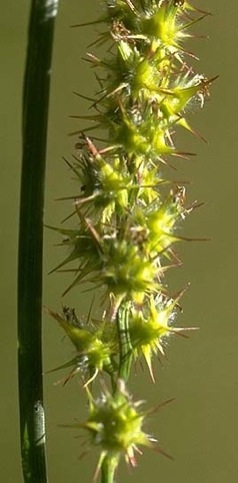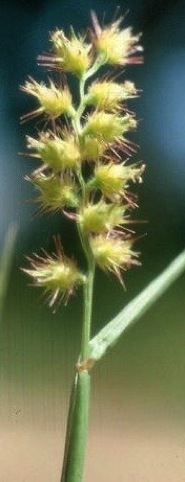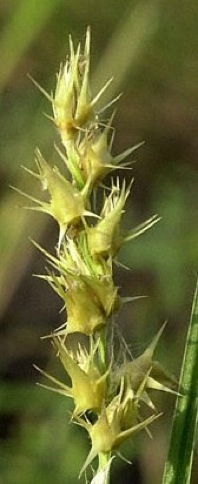Sandspurs: Cenchrus’ Secret
If I were ever to invent a torture it would be dragging someone naked through a field of sandspurs.
One of my uncle in the United States — Wray — was a professional when it came to lawn maintenance on a grand scale. But as with the case with many professionals, he never maintained his own lawn. While I agree with that in spirit, his sandy acre in Mims, Florida, grew nothing but sandspurs; big, mean ugly ones that reached out and impaled you. Sandspurs was my first big hint that Florida was not all paradise. Those and fire ants are rites of initiation to the Sunshine state.
I got my revenge, however, because sandspurs are edible. It really doesn’t make a difference which of the three local species I exact my revenge on because they’re all edible. The only issue is how to get at the seeds. There are four ways. You can burn the spines off in a fire using the rest of the stalk as a handle, kind of a semi-roasting. Eat the seed and hull then and there. While you do get a little charcoal this is by far the quickest and least energy-expending way to eat the sandspurs. Don’t let the spike of spines catch on fire because it will quickly burn to a crisp (they have a high oil content.) You want to just singe the spurs off. The second way is you can burn off the spines, pound the burned hulls off in a mortar, and winnow to get clean seeds. The freed grain parches well, makes a good porridge. Third you can put them raw in a big mortar and pound away until the spines and hulls are separated then winnow the pain away (to put in someone yard perhaps….) A fourth way is to rub the sandburs between two stout pieces of leather, separating the seed from the spines.
Sandspurs is one of those wild edibles that finds you, usually by getting in a shoe or grabbing onto your clothes. When I’m going out in grassy, sandy areas I always take with me a small pair of needle-nosed pliers. They are an excellent way to remove the offeners… er… edibles… In bad years I’ve been tempted to make a beer out of them… Sandspur Beer, sticks it to ya…
As for the name, Cenchrus (SENCH-rus, KENCH-rus): It’s from the Greek word kechri, meaning millet. Spinefex (SPY-ne-feks) is from the Dead Latin word spina, meaning spines. Echinatus (ek-in-AY-tus) means armed with spines. Incertus (in-KER-tus.) means uncertain, which is botanists admitting they are a bit confused by the plant and not sure what to call it. I suggest C. esculenta, (es-kew-LEN-tuh.) which in Dead Latin means edible.
Green Deane’s “Itemized” Plant Profile
IDENTIFICATION: Annual with stem tips from the lower nodes which bend and root, seed heads are spiny burs and are one to five inches long, to a half inch wide. There are two kinds of spines, flattened spines that are spread over the body of the bur and fine bristle-like spines on a ring around the base of the bur.
TIME OF YEAR: Year round in Florida, in summer and fall in northern areas.
ENVIRONMENT: C. echinatus grows in turf, cultivated and disturbed areas throughout warmer areas of the United States, from North Carolina to California; Mexico; Central America; South America; the West Indies; Pacific Islands; and Australia. Other versions grow as far north as Maine. Research to find your local Cenchrus.
METHOD OF PREPARATION: Grain, parched or winnowed, then cooked like any grain. Can be used to make a beer-like drink, porrage or mixed with other grains to make bread, or used to make a thin bread itself. Can have ergot-like fungus infections so watch for that. Ergot can look like black grains of rice.





To removing the sandspurs from your flesh or clothes if you don’t have needlenose pliers, try licking your fingers first. You will be surprised. They will not stick to you. [works better to re-lick for each bur]
George, native of St. Petersburg.
Im a native florida boy and have had to battle many a day with these things and we used to pull them out with our teeth and to my surprise the “spurs”won’t pierce your tongue, maybe the outside part of your lip but not your tongue try it out.your tongue is pretty tough.
I assume that your dragging treatment would be used on some professional botanists and people who speak latin. 🙂 great work…
Beautiful thing. This was probably the article that ‘hooked’ me by making eatable something beyond my tummy-imagination. All that wasted food on my socks…all that irritation and careful picking that coulda added up to a meal. I’d never even spotted what plant they came from.
Just discovered Jack Keller also made “sand burr wine:” “once won first place with jalapeno wine, second place with sandburr wine, and third with Bermuda grass clippings wine.”
Interesting. These (or some related thing) are called amor seco where I live. The rice farmers (who do rainfed rice) pound and eat as a famine food during drought.
How does this taste, I wonder?
The sandspurs are tasty. Amor seco is Desmodium adscendens, a completely different family. Some Desmodiums are edible, most are not.
In our village we call this amor seco. But we also call Andropogon aciculatus amor seco. So I’m not sure which of them– I should ask next time I come around
LOL! This is one plant we can all identify with!
All the comments here are notable. As a smaller,lighter child, we had some limited success escaping the midst of a sandspur patch with a gliding run. I’m about to advise a ranch hand, eye to eye, that pulling sandspurs is pointless & painful. As Green Deane’s video notes, they thrive in poor, sandy soil. Enriching the soil is a more logical, long term solution if you consider them a nuisance. I’ll be showing a top notch group of Permaculture students the roasting technique first & pointing out their brewing qualities. Thank you. Happy hoes, neighbors.
I’ve always known them as grassburs. Had 2 Catahoula Leopard hounds that would sit in a patch, gently pulling up the stem until they collected the seed head. Chomped them down like candy!! I should try some.
I would like to grow them and place them in the sand dunes. I have tried signs they do not work.
Dick Deuerling told me that he made soup for his Boy Scouts from sand spurs. No other details. (Grew up with sand spurs. Can’t change to sand burrs.)
Hi! I’m reading the Florida’s incredible wild edibles that you and Dick authored and saw your reference to this event, and when I saw the spurs weren’t in the book I came to Green Dean for more info. So good to see you here too!!
Many times they made my childhood happy because I used to play bare – footed in the green field near my house ! However , l like their small yellow flowers . My people name this plant ” draisa ” .
Enjoyed this article. I’ve known of many edible weeds, but did not know this was. I’m not only a Florida Native, but when I was born I was given the name Sandspur. Although I was given a different name on my birth certificate, I have some who occasionally refer back to Sandspur.